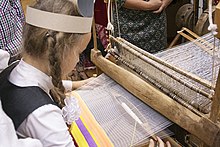
Back Prošlup Czech Fach (Weberei) German Passo (tessitura) Italian Przesmyk tkacki Polish Skäl Swedish



In weaving, the shed is the temporary separation between upper and lower warp yarns through which the weft is woven. The shed is created to make it easy to interlace the weft into the warp and thus create woven fabric. Most types of looms have some sort of device which separates some of the warp threads from the others. This separation is called the shed, and allows for a shuttle carrying the weft thread to move through the shed perpendicular to the warp threads. Which threads are raised and which are lowered are changed after each pass of the shuttle.[1]
The process of weaving can be simplified to a series of four steps: the shed is raised, the shuttle is passed through, the shed is closed, and the weft thread is beaten into place. These steps are then repeated, with a different set of threads being raised so as to interlace the warp and weft.[1]
The term shedding refers to the action of creating a shed.[2] A shedding device is the device used to raise or open the shed. Creating the separation is referred to as raising or opening the shed, while the reverse is known as lowering or closing the shed.
- ^ a b Cartwright, Wendy (2007). Weave. Murdoch Books. pp. 8, 35. ISBN 1-74045-978-4. Retrieved July 6, 2009.
- ^ Lord, Peter Reeves; Mohamed, Mansour H. (1982). Weaving: Conversion of Yarn to Fabric. Woodhead Publishing. p. 368. ISBN 978-0-900541-78-0.